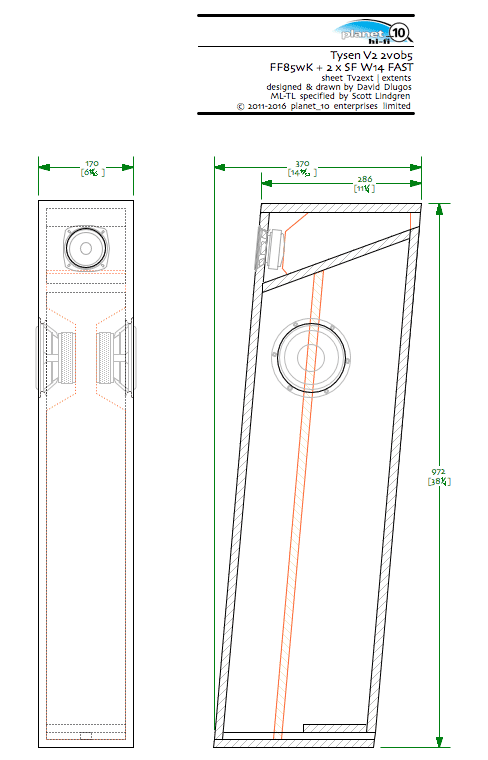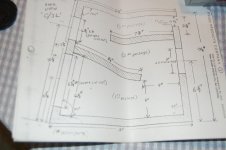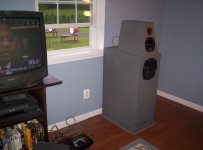Actual measurements showing the consequences of stuffing on driver and port sound output and driver impedance can be seen in post #1 at:
17 foot pipe sub 12-230 Hz ±5dB
Post #6 shows harmonic distortion results.
Puzzling to learn that Planet10 finds building a labyrinth and stuffing the complex structure by ear inside a box is no harder than just building a box for mid-range and tweeter drivers (which I take for granted do not have their resonance in their passbands). Nice to see that he has disclosed, at least implicitly, that he is referring to products he sells.
B
17 foot pipe sub 12-230 Hz ±5dB
Post #6 shows harmonic distortion results.
Puzzling to learn that Planet10 finds building a labyrinth and stuffing the complex structure by ear inside a box is no harder than just building a box for mid-range and tweeter drivers (which I take for granted do not have their resonance in their passbands). Nice to see that he has disclosed, at least implicitly, that he is referring to products he sells.
B
Last edited:
...building a labyrinth inside a box is simpler than just building a box for a mid-range driver...
Calling it a labyrinth is a bit of s stretch.

dave
ben - how exactly do you/we know for sure what the final frontier will be?
Off-topic, but since you ask: ALL other units of our systems are enclosed in longer or shorter feedback loops. Only our speakers have no feedback loop.
Yes, other bits can always be improved. But that's a major frontier.
BTW, rear pipes and TLs might meet the requirements for inclusion in motional feedback loops since the cone motion resembles the signal, unlike BRs.
B.
...other units of our systems are enclosed in longer or shorter feedback loops..
Not all.
dave
Actual measurements showing the consequences of stuffing on driver and port sound output and driver impedance can be seen in post #1 at:
17 foot pipe sub 12-230 Hz ±5dB
A bit like those in post 98 above then. Was Nautilus bunk? Which are measured results, not modelled.
Puzzling to learn that Planet10 finds building a labyrinth and stuffing the complex structure
So what you are saying is
a/ The impedance measurements above aren't really there, being merely a minor visual impairment that will doubtless correct itself in the fullness of time, and
b/ A single panel creating an unfolded tapered line is a 'complex structure'. Labyrinthine. Remind me to beware lest the Minotaur cometh. Fortunately, I have my ball of twine and a sharp stick to hand.
Puzzling indeed.
Nice to see that he has disclosed, at least implicitly, that he is referring to products he sells.
That speaker design was available to anyone who asked for plans, and as you know, is defunct and has been for some years due to the mid-tweeter being discontinued back in 2013. So on that basis yes: Dave is clearly making a strenuous effort to refer to a product he doesn't sell, and couldn't even if he wanted to given the unavailable nature of the main drive unit. Other than that, a highly accurate statement.
Just as obviously, he would not use a speaker he has measured and knows extremely well as an example, rather than something different he hadn't measured and was less familiar with. That would make much more sense, wouldn't it?
I know some people love to get their rocks off knocking Dave, and to be sure he is a vendor here, so he is. But it might be nice if they also bothered to get their facts straight first, and actually considered he might be providing some information which is perfectly well in line with well-known and understood physics as demonstrated by Augspuger, King & many others.
Last edited:
… due to the mid-tweeter being discontinued back in 2013...
Bass driver also became unavailable. Better midTweeters have come along, but i have yet to find something that fills the same role as the SDX7.
dave
I stand corrected. midtweet and midbass also, neither of which have direct replacements. Must be a big seller for you.
Having built prototypes and kits of a fair number of Dave and Scott's designs over the past decade or so, I think it's fair to say that in terms of actual enclosures, the big seller for Planet10 would be the FH3 kit.
Yeah both iterations of the Tysen were quite fun.
Yeah both iterations of the Tysen were quite fun.
The OP invited bunk into this thread right off the bat...
Sorry Eric. Threadjacking happens. Glad you started it.
Sorry Eric. Threadjacking happens. Glad you started it.
Last edited:
Actually, I think the invitation was to discuss whatever special flavour of “inspired by nature” Kool-Aid / bunk might be unique to the B&W Nautilus coiled tapered sealed woofer enclosure, but the last few pages have been so much fun to read that why stop now?
So kids, back to the sandbox - and no, I don’t think that’s an Oh Henry bar😱
So kids, back to the sandbox - and no, I don’t think that’s an Oh Henry bar😱
Only, it's not bunk... 😎
The lossy line has has an illustrious history within loudspeaker building, which Planet10 knows better than me. It's a variant on transmission lines approaching aperiodic.
The original enthusiast was Irving "Bud" Fried. I have a bit of Bud Fried's stuff. It's good.
Series crossovers quite often, good impedance always. Well behaved flattish drivers. And sometimes line loading when he wasn't doing the full transmission line.
Benefit of lines is they have far less of the impedance peak at the bass or Fs resonance, along with good control of the pesky backwave. That old tapered and acoustically damped cheesewedge had something going for it.
When you get to this level, because the room and the box become equivalent, you start thinking about room acoustics too. Listen to a good loudspeaker in a good acoustically treated room, and you will hear all sorts of things in the recording mix that you normally miss.
How does it end up looking? Like below in one variation. Not much wrong with that.
The lossy line has has an illustrious history within loudspeaker building, which Planet10 knows better than me. It's a variant on transmission lines approaching aperiodic.
The original enthusiast was Irving "Bud" Fried. I have a bit of Bud Fried's stuff. It's good.
Series crossovers quite often, good impedance always. Well behaved flattish drivers. And sometimes line loading when he wasn't doing the full transmission line.
Benefit of lines is they have far less of the impedance peak at the bass or Fs resonance, along with good control of the pesky backwave. That old tapered and acoustically damped cheesewedge had something going for it.
When you get to this level, because the room and the box become equivalent, you start thinking about room acoustics too. Listen to a good loudspeaker in a good acoustically treated room, and you will hear all sorts of things in the recording mix that you normally miss.
How does it end up looking? Like below in one variation. Not much wrong with that.
Attachments
I do not mind technical segues. Also, I did not specifically mean the conch shell design, but rather having a stuffed tapered tube behind a driver as an reduction in distortion, frequency and time related artifacts vs. a sealed approach. Even in the original Nautilus, B&W took both the straight and the curved approach to the design. Talking about variants, and comparison to other enclosure ideas, as well as advanced analytical techniques works for me so long as we keep "I love/loathe B&W " discussions to another thread. 🙂
Last edited:
If I forget Nautilus for a second, and only contemplate your objective of sequestering the back wave, the answer is simply a true infinite baffle. Not open-back dipoles. True infinite baffle opening to the outside of the listening room.
If we stuff a TL sufficiently it will behave like an infinite baffle. Maybe not that extreme, but the more we stuff, the more the impedance curve will flatten, the more the 2 impedance peaks will merge into one, and the more the response will approach infinite baffle. There are 2 equally valid philosophies to TL: use the back wave to augment the front wave, or absorb the back wave to accomplish the goals you set out.
The IB also has a famed sound. TL accomplishes the same resistively and that's just about the only difference from IB.
If we stuff a TL sufficiently it will behave like an infinite baffle. Maybe not that extreme, but the more we stuff, the more the impedance curve will flatten, the more the 2 impedance peaks will merge into one, and the more the response will approach infinite baffle. There are 2 equally valid philosophies to TL: use the back wave to augment the front wave, or absorb the back wave to accomplish the goals you set out.
The IB also has a famed sound. TL accomplishes the same resistively and that's just about the only difference from IB.
I think I finally begin to understand TL.
The first harmonic augments the front wave. That is the only thing we want from the output of the line. (Or not at all, because there are 2 equally valid philosophies to TL.)
The third harmonic is minimized by driver positioning, which has to be very precise, but once achieved, the third harmonic suppression is highly effective.
From the fifth harmonic onward, the stuffing absorbs them. If we leak any of these from the output, they become midrange leakage, not unlike midrange leakage from a bass reflex system. Many ways to deal with this include: opening to the back or the side, separating midrange into its own enclosure, use good stuffing which behaves like a high pass filter, etc. By this point we are way above tuning frequency, and there are many materials available good at absorbing midrange.
The first harmonic augments the front wave. That is the only thing we want from the output of the line. (Or not at all, because there are 2 equally valid philosophies to TL.)
The third harmonic is minimized by driver positioning, which has to be very precise, but once achieved, the third harmonic suppression is highly effective.
From the fifth harmonic onward, the stuffing absorbs them. If we leak any of these from the output, they become midrange leakage, not unlike midrange leakage from a bass reflex system. Many ways to deal with this include: opening to the back or the side, separating midrange into its own enclosure, use good stuffing which behaves like a high pass filter, etc. By this point we are way above tuning frequency, and there are many materials available good at absorbing midrange.
Last edited:
I do not mind technical segues. Also, I did not specifically mean the conch shell design, but rather having a stuffed tapered tube behind a driver as an reduction in distortion, frequency and time related artifacts vs. a sealed approach. Even in the original Nautilus, B&W took both the straight and the curved approach to the design.
I don't think you've quite grasped the fundamentals yet. There is no such thing as a 'straight approach' or a 'curved approach' to a TL variation, at least as far as acoustics goes. They are the same thing. It is a line of a given volume, axial length, and where applicable, taper ratio. With a large degree of latitude, it doesn't make any difference to its behaviour whether it's curved, folded or straight. The Nautilus bass line is curved the way it is
a/ to reduce cabinet size, and
b/ for aesthetic / styling purposes.
Simple as that. No mysteries, nothing to see here. You could unroll it & the line will perform the same way.
Bends in QW / TL designs can impact behaviour, as I've said before, but unless very sharp and / or associated with a change in cross section around that region, bass wavelengths are typically too long to be disrupted; it's the shorter wavelengths that tend to be more affected, which is why they can be used as a functional part of an acoustic low-pass; this is primarily of use in wide BW loads such as horns & have little particular impact for more highly damped or limited BW designs like most TL variations.
I don't think you've quite grasped the fundamentals yet. There is no such thing as a 'straight approach' or a 'curved approach' to a TL variation, at least as far as acoustics goes.
Which is kind of what I said very early on, Scott. 🙂
All I meant to do here is say that these discussions are exactly what I was looking for.
I do specifically have an interest however in the discussion regarding how much of the perceived benefit (if any) has to do with re-radiation from the driver of the original signal. All other discussions are bonus. 🙂
Best,
Erik
Last edited:
As did I.
It's a sealed TL, so there is no radiation (or reradiation) from the line. There may be some loading of the driver depending on line size & driver characteristics, but the details of both are unknown as far as the Nautilus is concerned so speculation would be meaningless. If there is, it should be loosely akin to a sealed box of equivalent volume; the line harmonic modes should be suppressed & non-issues. Beyond that, you're simply dealing with direct radiation, diffraction effects and minimising structural resonances.
It's a sealed TL, so there is no radiation (or reradiation) from the line. There may be some loading of the driver depending on line size & driver characteristics, but the details of both are unknown as far as the Nautilus is concerned so speculation would be meaningless. If there is, it should be loosely akin to a sealed box of equivalent volume; the line harmonic modes should be suppressed & non-issues. Beyond that, you're simply dealing with direct radiation, diffraction effects and minimising structural resonances.
As did I.
It's a sealed TL, so there is no radiation (or reradiation) from the line.
Right, so we all agree it is effective, and there is no internal echo.
But do we agree this particular feature has measurable sonic benefits compared to a sealed or BR enclosure in a box?
Best,
E
But do we agree this particular feature has measurable sonic benefits compared to a sealed or BR enclosure in a box?
I don’t really care if it is measurable… it falls into those kind of small details that get buried in standard measures that make the difference between good and great.
"Not all that matters can be measured, Not all that can be measured, matters." Jonathan Novick, Audio Precision
dave
- Home
- Loudspeakers
- Multi-Way
- Was Nautilus bunk?


